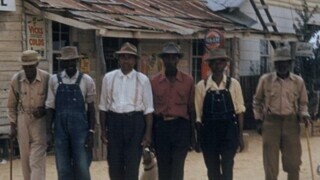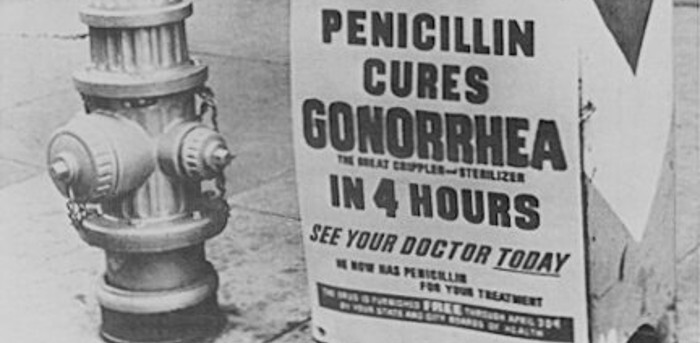The 15 Scariest Details of the Tuskegee Experiment

American white supremacy has imposed a lot of hardship on the black community -- slavery, Jim Crow, Vanilla Ice, etc. -- but possibly its most cartoonishly evil act of violence was the Tuskegee experiment. Starting in 1932, scientists identified almost 400 black men living near Tuskegee, Alabama who had syphilis and proceeded not to treat them for the next 40 years, literally just to see what happened.
Why Black Men?

(National Archives and Records Administration/Wikimedia Commons)
It seems over-the-top evil to randomly target black men for this kind of cruelty, and it for sure was, except it wasn’t random. The scientists thought the black community was inherently prone to STDs and couldn’t be convinced to get treatment anyway, so as far as they were concerned, they were just observing nature take its course. It all makes sense when you take into account their jaw-dropping racism.
Participants Didn’t Necessarily Know They Had Syphilis

(National Archives and Records Administration/Wikimedia Commons)
Scientists told the 399 infected participants and 201 control subjects that they were being treated for “bad blood,” a regional expression that referred to anything from syphilis to anemia and fatigue that could make you feel kinda crappy. As far as some of them knew, they were just a little tired. Of course, they weren’t actually being treated, just given aspirin and vitamins that they were told was medicine. A cup of coffee probably would have been more effective.
See? All on the Up and Up!
Potential participants knew something was amiss straight away, they just understandably couldn’t imagine exactly how horrifying it was. They actually assumed the study was somehow a trick to get them to join the military, so the scientists started recruiting women and children, although they didn’t actually become part of the study. They even received actual treatment for syphilis. That was how far these scientists were willing to go to convince men to sign up for slow, painful death: giving healthcare to black children.
Preventing Treatment
Despite the scientists’ assertions that they weren’t withholding anything the participants wanted, they went to great lengths to withhold treatment that patients wanted. They gave local doctors a list of subjects’ names with instructions not to treat them and even sent one of their nurses (we’ll get to her terrifying ass in a moment) to follow a participant to a doctor’s appointment to make sure he didn’t get any unapproved doctoring.
Get-Out-of-Army-Free Card

There were upsides to being doomed to a medieval peasant’s death, if you surround “upsides” with infinite air quotes. The scientists apparently had enough pull with the U.S. government that when participants were drafted into the army, they got them out of it just so their condition wouldn’t be discovered and treated. Dying on a World War II battlefield or blind and incoherent from a treatable infection doesn’t sound like much of a choice, but there is no but.
No Penicillin

In 1932, it was almost barely sort of rationalizable to withhold syphilis treatment, which often included ingredients like mercury and arsenic, because it could fuck you up just as bad. When penicillin became a miracle cure in 1947 and the health department began setting up clinics like Starbuckses, though, the scientists just neglected to mention that little revelation to their subjects. They would have slapped the syringe out of their hand anyway! Oh, wait, it turns out that 30% of participants managed to get their hands on some kind of black market penicillin, presumably after every doctor in town made up increasingly weird reasons to turn them away.
Free Meals For Death

For some reason, the study eventually had trouble getting participants to show up for their sugar pills, so they started offering incentives like free meals and healthcare (for, you know, non-syphilis things). The sad fact is that, during the thick of the Depression, they probably wouldn’t have had to conceal their motives even a little in exchange for a sandwich, which is why scientists aren’t allowed to do that anymore.
Burial Insurance

There was one more particularly morbid incentive participants were offered: burial insurance. This one wasn’t out of the goodness of their hearts or even just to get them to show up, though. It was to ensure access to their bodies for autopsies.
Eunice Rivers

She may not have been anywhere near the top of the evil hierarchy, but if there’s one villainous face we can put on the Tuskegee experiment, it belonged to Eunice Rivers. She was a nurse hired by the scientists to recruit and retain participants, the one who drove them around to appointments, delivered their meals and medicine, kept careful records of their comings and goings, and even performed the aforementioned reconnaissance. In the inevitable Netflix horror series, she’s gonna be the one in the thumbnail.
Whistleblowers Were Ignored
In 1966, health department investigator Peter Buxtun started to suspect people weren’t actually volunteering to not get treated for syphilis and asked his superiors to look into it. They did and decided … that it was totally fine. He wasn’t the only health official with misgivings at the time; another was Bill Jenkins, a black health department statistician who wrote about his concerns in the anti-discrimination newsletter he ran. Unfortunately but unsurprisingly, no one read it.
Oops, Too Late

(National Archives and Records Administration/Wikimedia Commons)
Even if these whistleblowers had succeeded in putting the heat on the Tuskegee scientists, it wouldn’t have made much of a difference in their approach. In 1965, they argued that, well, maybe they should have given the participants penicillin when it was introduced, but they were too far gone at that point for treatment to do them any good. That’s completely untrue, incidentally, but racism has never let facts get in the way of a genocide.
It Took 40 Years to Uncover
By 1972, Buxtun had gotten tired of waiting for his colleagues to wake up one day and decide to stop being evil and went to the media, and on July 25, the Associated Press published a report that blew the whole thing open. It still took another four months for the government to officially end the study because bureaucrats be bureaucratting.
Here’s Hoping You Weren’t Rooting For a Happy Ending

(National Archives and Records Administration/Wikimedia Commons)
Spoiler: Things did not go well for the participants of the Tuskegee experiment. By 1972, only 74 were still alive, and while that may not be totally unexpected for a 40-year study, 128 of them died directly of syphilis or its complications. An untold number went blind or deaf or suffered a number of mental and physical illnesses, and 40 of their wives and 19 of their children were infected over the course of the study. But hey, now we know that untreated syphilis is bad.
They Got Away With It
In 1973, survivors of the Tuskegee experiment and its deceased victims’ families got about as far as “We’re suing y—” before the government agreed to a settlement, but it was only for $10 million split between dozens of people and the promise of medical care, which, you know, “Fool me once” and all that. No one involved in the study ever faced legal consequences.
Black Men Still Die Sooner Because of It

Thanks to distrust of the medical system engendered by the Tuskegee experiment, one study estimated that life expectancy of black men at age 45 fell by 1.5 years after the experiment was made public. That’s right: It was so racist that it’s killing people who weren’t even alive when it started.
Top image: National Archives and Records Administration/Wikimedia Commons